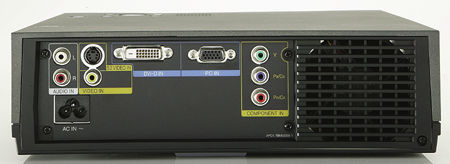Panasonic PT-L300U LCD Projector
Some of the most affordable front projectors are coming from the pro divisions of well-known companies. Want to pay around $2,000 for an LCD projector? Consider the Panasonic PT-L300U. It hails from the Presentation Systems Group of the Panasonic Broadcast & Television Systems Company, but don't let that deter you. This projector is fully home-theater-worthy. Judging from the happy-android family pictured on the cover of the instruction manual (as opposed to happy-android executives), that must be intentional.

With a resolution of 960 by 540, the PT-L300U doesn't match any existing television format, but it converts most of what it receives to a resolution that falls somewhere between standard and high definition. The 1,920-by-1,080 HDTV format is exactly twice the projector's native resolution, which makes for a clean downconversion that looks really good, and the projector is more than a match for DVD's 720-by-480 resolution.
Gosh, it's a cute little thing. It's 3.4 inches high by 11 wide and deep, and it weighs just 6.4 pounds. It's styled in dark gray, almost black, with a subtle glass front panel and silvery zoom/focus rings. The handful of top-panel controls (which I never touched) include menu navigation, input, keystone, and power-on/standby. The side panel has an SD memory card slot, so you can easily display digital stills. On the back panel are DVI-D (it lacks HDCP), component, S-video, and composite video inputs, along with a PC input and the fan.
The PT-L300U's rated fan noise is 28 decibels, and I'll take Panasonic's word for it, since my SPL meter doesn't go that low. That makes it one of the quietest solid-state projectors I've used, which is a big deal in my cramped urban space, where a wall mount holds the projector over the sofa. No one's going to install a noise-insulating projection booth to house a compact solid-state projector, so Panasonic gets extra ergonomic points for attending to this matter.
The projector ran hot (I've never known a compact front projector that didn't) but not hot enough to shut down while I used it. Thanks to surprisingly temperate July weather in New York, I rarely ran the air conditioner while I had the unit, and it operated in an average room temperature of 82 degrees without showing any quirks.

As I do with any projector, I worked my way through test patterns from the Avia DVD to set black level, white level, and color. In addition to the standard brightness and contrast controls, the PT-L300U includes a gamma menu that lets you separately adjust blacks without affecting whites, and vice versa. In the Avia black-level test, the black level is supposed to be correct when one of the two shadow bars disappears from the test pattern's black portion. Dropping the black-level gamma control to the bottom of the PT-L300U's range didn't quite achieve that goal, so I added a modest reduction in the brightness control. The fact that I was using a grayish Stewart FireHawk screen probably helped.
The white-level gamma and contrast settings ended up at zero, as did most other picture settings, with a few exceptions: I reduced detail nearly to the bottom of its range. Anything higher (even the center setting) led to distortion and haloing. Using Avia's color-bar/blue-filter test, I reduced color saturation by one tiny increment. I viewed the color decoder with patterns and filters, and it was just about spot-on. With movie material, it would impress me time and again.
The PT-L300U has several picture modes, labeled Normal, Cinema1, Cinema2, Music, Sports, and Dynamic. Except for the Cinema1 (and perhaps the Normal) mode, all of the modes had an unacceptably blue color temperature. I stuck with the Cinema1 mode for nighttime viewing. You can adjust color temperature in five numbered steps. I settled for the 0 setting, which generated a neutral white, neither blue nor sepia. For extra credit, you might explore the color-temp user menu, which allows separate contrast and brightness adjustments for red and blue. I'm not quite that dedicated.
The PT-L300U offers several ways to manipulate screen shape and positioning. Keystone controls allow for off-center placement, including both horizontal correction (when the projector shoots from the side) and vertical correction (if the projector is not at the perfect height). Since this adds an extra burden to the scaler, a geometrically correct placement would be a better option, even if you have to pay an installer to do it. The projector also has controls that offer modest degrees of vertical and horizontal lens shift.
Aspect-ratio controls include the usual 16:9, 4:3, stretch (called Just), and letterbox (Zoom) settings, as well as a V Scroll setting that makes the picture 1.2 times (20 percent) larger. Finally, you get wide and nonwide settings called S16:9 and S4:3, respectively. The S stands for signal-through. These modes deliver only the pixels in the source signal, without resizing, which results in an image that's 11 percent smaller for standard-definition and analog signals. The projector auto-detects high-def signals, and you can only view them in the non-S modes.
While this projector is easy to use, it has one ergonomic flaw that haunted me every time I adjusted the picture. The basic picture controls are in a submenu within the main menu. Changing any picture parameter always starts with two (or more) keystrokes, and then it takes another two keystrokes to exit. Once I got the picture where I wanted it, the menu structure was no longer a problem, but it was annoying early on. The remote does have direct-access buttons for aspect ratio and picture mode.




























































